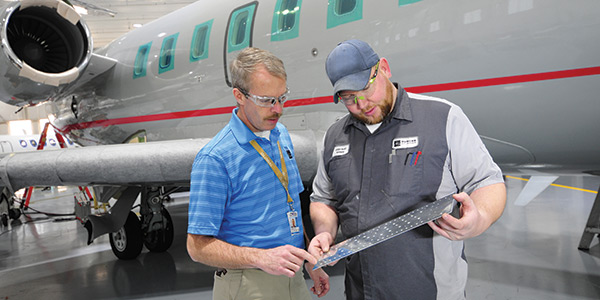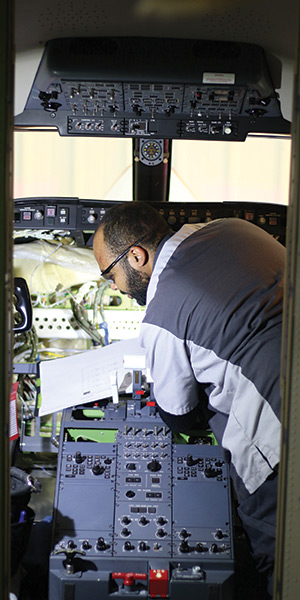When comparing maintenance quotes from different MRO (maintenance, repair, and overhaul) facilities, there are a staggering number of variables to consider. We sometimes hear from operators who choose the lowest quote and go elsewhere, only to discover their project’s out-the-door costs far exceeded their other quotes. That is why looking at the numbers on each proposal and not verifying the details of what is quoted often leads to items being missed or added to the invoice after the aircraft is input.
Operators should go to great lengths to ensure they are as informed as possible about what is being quoted and how potential findings could affect the quoted work. They should know exactly what is included in their quotes in order to have an accurate budget number prior to input.
To help make this process easier, we have compiled a list of questions and discussion points to help you get the details behind the numbers. This is not an all-inclusive list, but it is a great place to begin.
The best advice Brad Lennemann, Airframe Service Sales Rep for Duncan Aviation, offers those who need to compare proposals is to ask questions and not assume the bottom line includes everything. “When it comes to comparing quotes, you should be more concerned about what is not listed than what is. If you don’t see a line item for interior R&R or consumables or freight charges, for instance, ask if they are included.”
Here are some things to begin the proposal conversation.

“An MRO doesn’t like surprises any more than the customer does,’” says Dennis Kruse, Avionics Sales Rep. “It is important for the customer to spend time reviewing part numbers and prerequisites with the sales team to ensure an accurate proposal.”
According to Suzanne Hawes, Completions and Modifications Sales Rep, the number of variables that impact a quote for paint and interior completions work is nearly inexhaustible. Due to the variations between aircraft makes and models, it can be difficult to determine what the final quote includes. “Understanding everything included in the quote is key to getting the quality and appearance that you want out of an interior refurbishment,” she says.
Suzanne says operators should remember that, “It is very difficult to clearly communicate a value that isn’t easily represented in a number.” For instance, Duncan Aviation recommends removal of certain inspection panel fasteners when an aircraft is being repainted. This helps to reduce paint chipping when fasteners are removed and reinstalled during future maintenance events and helps to ensure the paint will look nice for a longer period of time. “Asking about this process during the bidding phase of the project will help set expectations for everyone involved,” she says.

Aircraft interiors are another area where it can be even more difficult to gauge the extra effort and care that might go into the project but that isn’t clearly represented by a number. Some things Suzanne cautions operators to clarify in their interior proposals include:
Mike Bernholtz, Engine Service Sales Rep, says if you want the most complete quote for engine maintenance, provide as much information as you can up front to your salesperson. “If logbooks are provided, we can accurately quote work on SBs (Service Bulletins), life-limited component replacements, and required ADs (Airworthiness Directives). If we are unable to review this information, the estimate could be off exponentially.”
Mike warns operators who have engines that are not on service programs to find out what level of service facilities are quoting. “If the quote simply has the lowest minimums available for the engine, I can guarantee you will end up paying more in the end. The MRO should be up front about the expected expenses and should let you know the parts and other components that typically need replacement.”
He advises that in addition to the base engine overhaul price, ask if the quote includes:

Landing gear quotes can be offered in a variety of pricing structures. NTE (Not To Exceed) is the most popular and the structure used most often at Duncan Aviation. With NTE, you are provided with the maximum quote and an assurance your final bill will not exceed that quote. Often, the final bill is under the NTE price.
Other options are Firm Fixed and Standard. With Firm Fixed, you are provided with the final bill before your gear arrives. It comes with a no bill-back guarantee, regardless of the condition of the gear. Standard Pricing includes all labor required to perform the normal inspection or overhaul and required parts. Any discrepancies found during the inspection that require additional parts and labor will be quoted over and above.
Jon Hein, accessories service sales rep, says each pricing structure has its advantages and advises you to select the one that makes the most sense for you. However, be aware of the exceptions. “Pay close attention to the exclusions on the contract,” Jon says. “They can add extensive additional costs not included in the quote.” These include additional customer requests, optional Service Bulletins, missing or abused parts, replacement of life-limited parts, and engineering fees, if required.
When reviewing your landing gear proposal, ask the following:
Evaluating the many quotes an operator receives in the course of preparing for an aircraft service event can be an overwhelming experience.
“Ultimately, the success and satisfaction of a project is a team effort,” says Skip Laney, Service Sales Rep. “The customer is as much a part of the team and its success as we are.”
The bottom line is that you should feel comfortable calling the MRO salesperson and having them walk you through the quote so you can better understand the proposal details as well as the ultimate workscope.